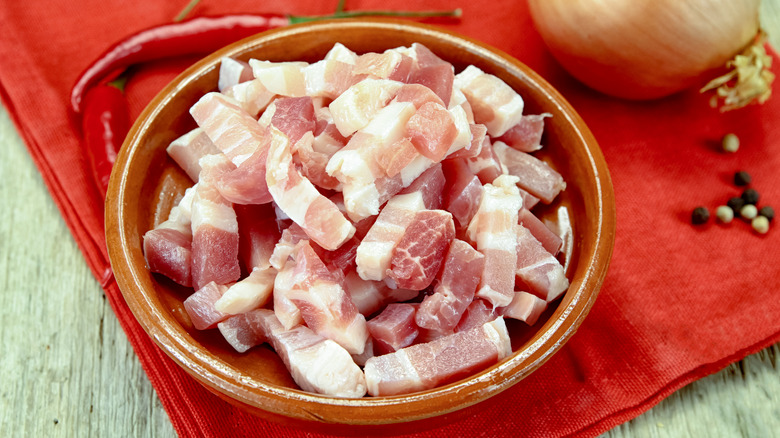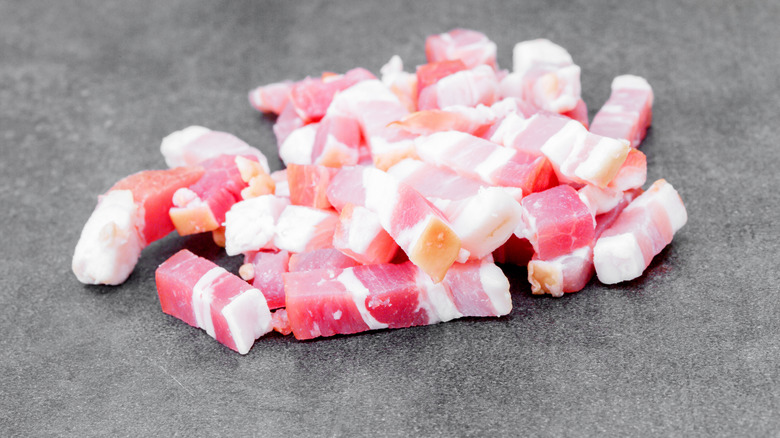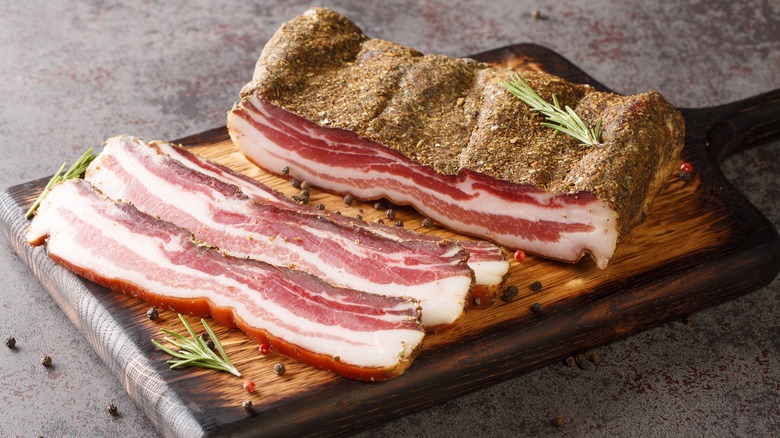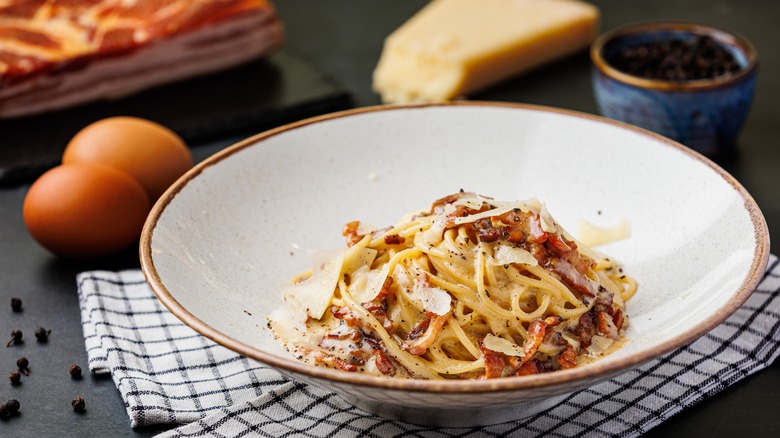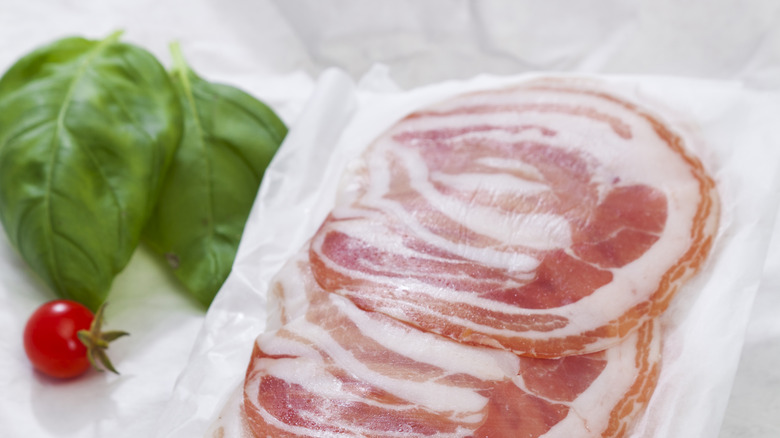Is There Any Difference Between Lardons And Pancetta?
Few preserved meats beat the tasty malleability of cured pork. Upon a foundation of salt, the technique opens wide-ranging flavor possibilities. From smoking to adding varying seasonings, changing the brine style, and taking on distinct butchering, many flavor-altering factors occur during the curing process.
Throw in renditions found in varying cuisines, and it's no surprise the product comes in so many forms. To make the best use of each one, it's helpful to consider the distinctions, like the difference between bacon and speck. And few cured pork types have a more slight distinction than is found between lardons and pancetta.
Both are extra-fatty and smoke-free, making them a great choice to cook with. They're ideal for slow-cooked dishes and do well when pan-fried to a crispy state. As a result, it's easy to think the two pork products are completely interchangeable. However, pancetta takes on a distinct thin slicing and spiced seasoning, which lends it a distinct character from the more fat-focused lardons.
What are lardons?
Lardons are a French cousin to bacon, a fatty and delicious cured pork ready for culinary application. They're most often used to build flavor in slow-cooked dishes, lending a delicate pork flavor to dishes like coq au vin. The meat comes as a short strip around an inch in length, reminiscent of bacon bites. However, lardons aren't smoked; they are packed with a rich, salty flavor. Nevertheless, they're still typically sourced from pork belly.
Due to their cut and curing, lardons have distinct textural qualities. After time over the heat, the exterior crisps while the interior retains a meaty consistency. They'll release ample fat but won't turn crunchy and transform like bacon. As a result, they are utilized as a fat source, interlinking with the antiquated practice of larding. When meats used to be much leaner, thin strips of pork would be threaded into cuts for moisture. While the technique isn't as applicable in modern cooking, lardons still supply a delicious source of pork fat and flavor.
What is pancetta?
Coming by way of Italy, pancetta is another cured pork product, also derived from pork belly. It's typically butchered into wide, circular slices, with the slab encased in string to preserve such a shape. Typically, the meat is sliced into thin rounds with attractive fat swirls. However, it's also available cubed for sauteeing. While typically not eaten raw, there are a few varieties that can be eaten without preparation.
Most pancetta is made without any smoking during the creation process. However, the cured meat is seasoned with a spice mixture containing ingredients like pepper, nutmeg, allspice, and fennel seed. Along with the salt during the curing process, these seasonings infuse the pork with flavor, giving it a distinct taste compared to other cured products. This means pancetta is expensive, but its palate is tricky to replicate.
Once cooked, the pork starts to melt, functioning as the start of an aromatic base. With its thin shape, pancetta can also be used as a wrap before cooking. And fried to crispy perfection, it functions as a delicious topping.
Lardons and pancetta have differences in shape and seasoning
The two cured products are similar, especially in their chopped form. They offer a salted pork flavor, free of any smoky notes. Once cooked, both take on soft, meaty consistencies internally, lending a rich note to dishes. As a result, they're a viable substitute, especially in slow-cooked dishes. However, they're not identical products, so it's useful to consider the nuances in their palate.
Most notably, pancetta contains spice seasonings, ranging from mild aromatics to bold, peppery additions. Integrated with intricate curing methods, this lends the pork product a complex quality at the forefront of a dish. Meanwhile, lardons have a more straightforward salty flavor, emphasizing the pork's intrinsic taste.
Additionally, pancetta is found in sliced form, which lends it to different uses than lardons. It can wrap around ingredients, be fried into thinner strips, and have uses similar to cold cuts. Pancetta's most common rounded form makes it easy to distinguish the two visually.
The two pork products offer varying culinary uses
Hailing from different culinary traditions, the two cured porks have distinct uses. As a staple in French cooking, lardons are a core component in a wide range of dishes. They lend a slow-cooked backbone to dishes like boeuf bourguignon and are a fried topping in a fresh salad like frisée aux lardon. Lardons are a crucial topping on tarte flambée, a bacon, onion, and cheese pastry from the Alsace region. While substitutions in such recipes are possible, it's best to stick to lardons for the most faithful French renditions.
Analogously, pancetta takes on a wide range of Italian interpretations. It's a terrific addition to pasta, complementing ingredients like asparagus and leek or even roasted squash. It can be used in risotto and add a pork note to dishes like clam arrabbiata. Plus, as opposed to lardon, certain varieties of pancetta are consumed raw and included in sandwiches and charcuterie boards. This lends the Italian cured pork an irreplicable character, making it a salted meat worth seeking out.
